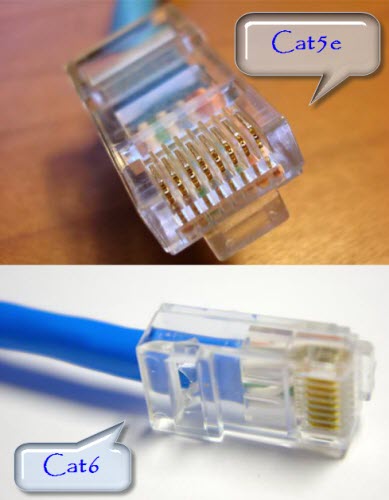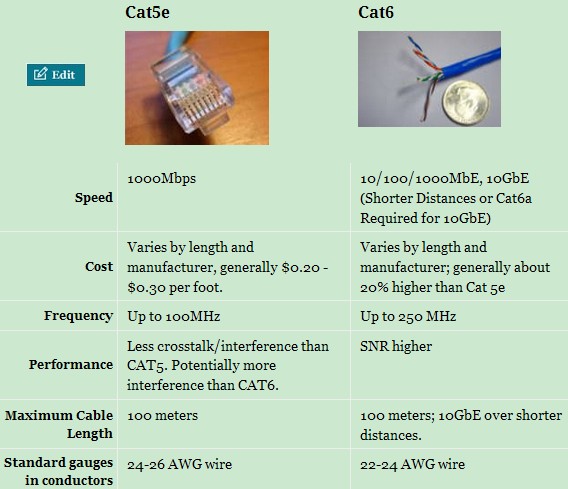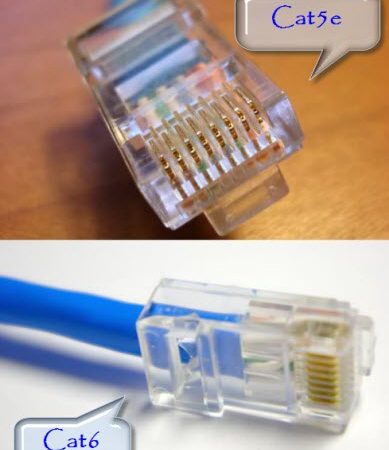In the last article, we discussed the differences between CAT5 cable and CAT5e cable. So we have got the main features and info of Cat5 and Cat5e. In this article, we will continue to talk about the main Ethernet cables: Cat6 cables and Cat5e. We will list the main differences between Cat5e and Cat6.
Cat6 cables, also called Category 6 or Cat 6 cables, provide lower crosstalk, a higher signal-to-noise ratio, and are suitable for 10GBASE-T (10-Gigabit Ethernet), while Cat5e cables support only up to 1000BASE-T (Gigabit Ethernet). As a means of future-proofing your network, Cat6 is generally a better choice and worth the small premium in price. Cat5e and Cat6 cables are both backwards compatible, which means newer Cat6 cables can be used with older Cat5e, Cat5 and even Cat3 equipment.

Comparison of Cat5e and Cat6

Wiring
Both Cat5e and Cat6 are twisted pair cables that use copper wires, typically 4 twisted pairs in each cable. The specification for Cat6 features more stringent specifications for crosstalk and system noise, and provides performance of up to 250 MHz. Cat5e, in contrast, performs up to 100 MHz. This was often achieved using a spline (a longitudinal separator) in the wiring, which isolates each of the four pairs of twisted wire. However, this made Cat6 cables more rigid; newer cables use other methods to reduce noise and are more flexible. Regardless of whether a spline is used, a cable that meets Cat6 specifications provides significantly lower interference or near end crosstalk in the transmission. It also improves equal level far end crosstalk (ELFEXT), return loss and insertion loss compared with Cat5e. The result is less noise, fewer errors and higher data rates in the transmission of the signal.
Original YouTube Video: https://www.youtube.com/watch?v=bKMMoYsBa7Q
Tips: Your computer uses these to talk to other computers-network Cat5e and Cat6 cables.
How to Identify
The category is almost always printed on Ethernet cables. It is not possible to identify cable categories by color, but Cat6 cables are often thicker than Cat5e because it uses thicker copper wires.
Maximum Length
Both Cat5e and Cat6 cable specifications allow lengths up to 100 meters, but Cat6e has a lower max length (55 meters) when used for 10GBASE-T (10 Gigabit Ethernet). In order to run 10GBASE-T for 100 meters, Category 6a cable, or Augmented Category 6, cables need to be used. Cat6a cables allow performance up to 500 MHz.
If network infrastructure requires covering distances larger than 100 meters, repeaters or switches are required to amplify the signal.
Speed, Cat6 cables and Cat5e
As mentioned previously, Cat6 cables can be used to power 10GBASE-T, or 10 Gigabit Ethernet, while the maximum that Cat5e cables can support is 1GBASE-T, or 1 Gigabit Ethernet. This is because Cat6 cables perform up to 250 MHz, more than twice that of Cat5e cables (100 MHz).
Cost of Cat6 and Cat5e
The price of Ethernet cables vary by length, manufacturer and seller. In general, Cat6 cables are 10-20% more expensive compared with Cat5e cables. However, cables are generally cheap and the speed boost offered by Cat6 cables usually makes the price premium well worth it, even for home use.
More Video Examples from YouTube: Difference between CAT 5, CAT 5e & CAT 6 cables
Rs from https://www.diffen.com
More Related Cisco Cable Topics:
Cat5 vs. Cat5e
Ethernet Crossover Cable vs. Ethernet LAN Cable
How to Make Your Ethernet Crossover Cable?
How to Create a Console Cable & Make a Console Connection?
Cisco Console Cables, Popular Types You Used






